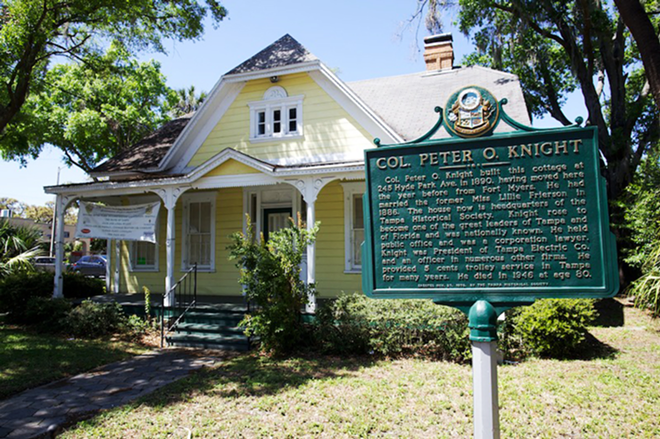Hyde Park hasn’t always been the tony neighborhood we now know and love. It suffered years of being ignored, chopped up or simply neglected. As a young urban planner, I was around for its fall and rise.
What were Hyde Park’s problems? First, the streetcar which ran up Bayshore Boulevard and along Rome Avenue was ripped out in the late 1940s. The bungalows that were new and nice in the 1910s and ’20s were getting older and required maintenance. Fashions and economics changed after WWII, and the GI Bill subsidized car-oriented suburbs. The area faded.
The neighborhood’s real estate values declined, and slumlords, particularly Emilio Ippolito, bought grand old homes and cut them up into single-room occupancy apartments. With fewer homeowners, the area got shabbier. Neglect bred neglect.
“In 1973, Hyde Park was rough and scruffy and so was I, so it was a good fit,” explains Charlie Greacen, a young artist who moved to Tampa as a cartoonist for the Tampa Tribune. He chose a well-worn walkup on Richardson Place which he named “Dilworth Manor” in honor of Philadelphia’s educator and former mayor, Richardson Dilworth. Journalists Greg Tozian, Dan Ruth and George Meyer were among the Dilworth Manor alums whose legendary parties enlivened the burg.
Hyde Park was cheap and fun and bohemian. Rick Miller saw a for-sale sign in 1975 for a house with a VW in the driveway, and he figured that he could afford to live in the rundown but charming area. After purchasing his home for $40,000, someone cut his garden hose and siphoned gas from his car during the gas crisis. Vagrants slept against his door.
After living in a squat in Amsterdam, Jan Abell, a young architect, moved to Hyde Park in 1976. She and her librarian husband tried to purchase a 3,177-square-foot home built in 1922 on Newport Avenue, one block off Bayshore Boulvard, for $36,100. Her mortgage application was denied, as loan officers asked, “Why would any bank offer a 30-year mortgage on a 60-year-old house?” The concept of historic preservation had yet to reach Tampa.
Since the entire neighborhood had been redlined by de facto white banks (yes, banks were segregated at that time), Jan, a white woman, could borrow only from a black bank, where the loan officer, James Hargrett, was accustomed to lending money in “unstable areas.” He later went on to be a state legislator and senator, always supporting funding for historic preservation projects.
My college experience at Tulane University was shaped by living in New Orleans, where I became an ardent preservationist. Returning to Tampa, I worked as an urban planner engaged in drafting a redevelopment plan for Hyde Park, under the visionary leadership of Del Acosta.
In 1975 I met Jan, who yelled at me for the neighborhood’s sorry state of affairs. Together with many others, we helped create a local chapter of Neighborhood Housing Services (NHS), a coalition of planners, neighbors and bankers who worked hard to develop a plan for improving this very funky area. Rick Miller joined NHS, as did Charlie Greacen, and things began to change. Jan died 14 years ago in a fox hunting accident.
Shifting the thinking of the town’s power brokers came slowly. Although the City of Tampa commissioned a survey to assess the number of historic buildings and homes in the greater Hyde Park area, ranging from Bayshore Boulevard to Kennedy Boulevard with Howard Avenue as the western boundary, the only part to be protected by the Architectural Review Commission (ARC) was the southeasterly portion, south of Swann and east of Rome avenues. Expanding these original boundaries took decades and lots of political bloodshed.
Speaking of skirmishes, the school board at one point decided to demolish Gorrie Elementary School, a naturally integrated school built in 1903, and use the property as a parking lot for Wilson Junior High, a block away. Their staff’s questionable reasoning was that since it was such an old neighborhood, there would be a diminishing number of children in the area, so an elementary school wouldn’t be needed.
Without gaining permission from my boss, I appeared before the board and cited statistics on national trends toward revitalizing older areas and begged them to reconsider their action. They did, and five years after that, Gorrie was bursting at the seams. Even today, it is the flagship elementary school in the public system and the only one with its own private foundation to pick up the tab for extras like art teachers and music lessons.
In 1975, the Crosstown Expressway was under construction, biting into the edge of Hyde Park, creating an impenetrable barrier to the north and west portions of the neighborhood. This “Maginot Line” was ultimately helpful for separating the Bayshore-oriented parts of the neighborhood from the Kennedy Boulevard portion. The dramatic split sped up reinvestment in the Bayshore portion, which had always claimed the advantage of the water views and grandest homes.
Everyone complains about the protective regulations which control the exterior appearance of homes and shops, but they are effective. Hyde Park is increasingly appreciated for its neighborhood schools, walkability, charm and character.
Rick Miller became a realtor in 1985 and has witnessed the upward shifts in value. “When the [real estate] faucet came back on last year, it came on full blast. In March, a purchaser set a new benchmark, $407 per square foot.”
This week Hyde Park is celebrating its 100th birthday as a neighborhood. Pretty impressive!


